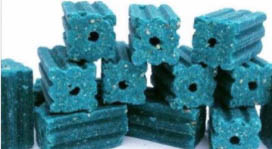Months ago I was visiting my brother and his family in Texas, standing outside of his house with his wife, when his 6 year old daughter came running up to us, holding a small blue plastic cube in her small hands, asking what it was. It looked like a discarded piece of candy. Matter-of-factly, he answered “It’s rat poison,” prompting my sister in law to look horrified, quickly snatch it away, and hurry into the house to throw it out.

Rat poison is just one of many products you can easily buy at your local hardware store. It can be found in an aisle dedicated to products intended to kill. If you have rats, mice, spiders, grubs, beetles, moles, voles, there is a product for that.

Would people still buy rat/mice poison if they knew it causes a slow, agonizing death that often takes several days? What about if they knew that animals other than rats are easily affected, for instance, when they eat the dead rat, or ingest the poison themselves? Family dogs, outdoor cats, owls, hawks, foxes, raccoons, opossums and many other animals can’t resist the stumbling, struggling rats or mice that have eaten the poisons, but have not yet died. These larger animals can also die slow, agonizing deaths, their bodies sometimes filling up with blood and leaving them helpless, and suffering, for days. If your dog–or your neighbor’s dog– dies from ingesting rat poison, is that something you can live with? Audubon says of animals affected by rat poison, “Their heads droop, the linings of their mouths are pale; some bleed from their eyes, nose, lungs, or other organs.” Most people are unaware of the collateral damage of these poisons.
Audubon says, “A four-year survey (1999 to 2003) by the Environmental Protection Agency found that at least 25,549 children under age six ingested enough rodenticide to suffer poisoning symptoms. Currently about 15,000 calls per year come in to the Centers for Disease Control from parents whose children have eaten rodenticides. Even if you place bait where children can’t get it, rodents are apt to distribute it around your house and property.”

So what’s a person to do who doesn’t want their home or their yard overrun with mice or rats? There are safer alternatives to these weapons of mass destruction. Unfortunately most people just want the quick solution, and the one they can put out and then never think about again. But maybe next time, before you hit the “easy button,” and buy these rat baits, think of your neighbor’s dog, your own dog, or all of the wildlife that will unnecessarily suffer. Instead of using first and second generation rat poisons, you could use live traps and then relocate the animals.

I’m expecting some readers to write to me suggesting another solution–outdoor cats, but please know this is not a solution any environmentalist would recommend, considering the animals killed every year by outdoor cats. Scientific American did a study in 2020 and concluded that, “Recent studies find that outdoor cats in North America take out between 10 and 30 billion birds and mammals each year.” Thus, allowing your cat to roam free outside is not a reasonable solution.
No one wants mice or rats in their house, but with a little more effort, we can address the problem in a more humane way, and one that won’t harm so many non-target animals.


